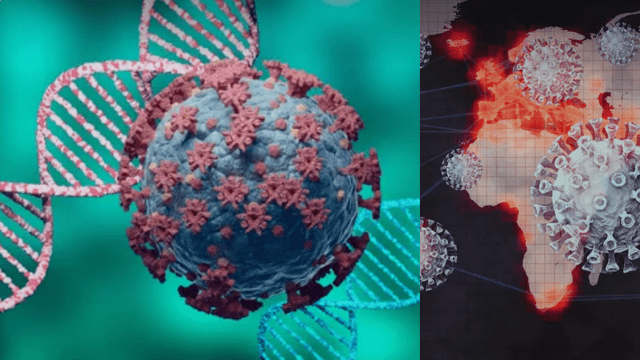Viruses copy themselves always. And during the copying process, they may make mistakes in copying the right letters or even lose or gain a whole bunch of letters. The cumulative effects of such mistakes lead to mutations. A single or double mutations may not produce a variant. But multiple mutations leading to a change in the virus’s normal behaviour do produce a variant.
The scary part of the current coronavirus story is a scenario where two different coronaviruses infect the same person at the same time. The genomes of the two different coronaviruses theoretically might recombine to form an entirely new coronavirus that is potentially more dangerous than the parental coronaviruses!
But not all coronavirus variants are worrying. A variant is termed successful if it could dominate by increasing its transmissibility or infectivity. Most variants are harmless and only a few are of health concerns.
Join our WhatsApp ChannelSevere acute respiratory syndrome coronavirus 2 (SARS-CoV-2), that causes the COVID-19 disease condition, is able to infect people through its spike proteins, which are structures that project from the surface of the virus. The spike ( or S protein) is made up of two subunits: S1 subunit is at the N-terminal region or the globular head of the S protein, and the S2 subunit found at the C-terminal region or the stalk of the S protein.
These two regions perform essential roles in the infectivity of the virus. Upon the virus infecting a host, the S1 subunit recognises and binds to the host cell receptors. The S2 subunit then fuses (or joins) the virus with the host cell membrane. Without the S protein, the virus would be unable to infect people, hence most of the vaccines in current use are targeted at the S protein.
SARS-CoV-2 soon after making its jump from animals to humans (as widely believed), started to adapt and spread by creating mutants. The more it spreads, the more chances it has to making important evolutionary leaps.
The Alpha (or B.1.1.7) variant was first detected in the UK and fully sequenced in September 2020, and soon after it was detected, it spread to almost all parts of the world. The difference between this variant and the original (or wild-type) SARS-CoV-2 was as stated before, the many gene mutations on the spike protein, which enabled the virus to be more transmissible than the wild-type, in most cases as much as 70% more transmissibility! It had 23 mutations compared to the original SARS-CoV-2 from Wuhan, China.
Shortly after the Alpha variant, the virus underwent another round of mutations and produced the Beta variant, which was first detected in October 2020 in South Africa. The mutations caused the virus to gain more transmissibility but it did not appear to be more potent in causing death or hospitalisation as the wild-type.
In December of last year, the virus again underwent mutations that gave rise to a new variant called, Delta (B.1.617.2). The variant first detected in India, caused a major surge in many countries by its highly contagious nature, and is currently the dominant strain in the UK and USA. Its transmissibility is about 50% compared to other variants and the wild-type.
In the same month of December 2020 a new variant called R.1 was detected first in Japan and in March 2021 it spread to the USA and peaked in May 2021. It was particularly concerning because it caused infection in fully vaccinated elderly persons.
In January of 2021, a new variant of the virus called, Gamma (Lineage P.1), was detected in four people who had arrived in Tokyo from Brazil. This time the virus had really perfected its acts as the then new variant was so highly contagious than the previous variants, including the wild-type virus, that it even reinfected people that had already had previous exposure to SARS-CoV-2!
The virus certainly has a way of keeping us busy for it produced another variant called Mu (B.1.621), first detected in Columbia in January 2021. In addition to the above variants, more have been detected: Epsilon (detected in the USA), Kappa (detected in India), ETA (detected in UK), Zeta or Lineage P.2 (detected in Brazil), Theta or Lineage P.3 (detected in the Philippines), etc. These variants are not as worrisome as the previous ones in transmissibility and ability to cause death or hospitalisation.
And just when we thought that we could not possibly run out of letters in the Greek alphabet, we have another variant, this time called the Omicron! This variant was first reported in South Africa and Botswana though it already was present in the Netherlands, Belgium and Germany before the reports. The virus was first identified in 10 to 30-year olds, meaning that it has been rapidly passing from person to person before its detection. This is because, this age bracket is highly mobile compared to other ages.
Omicron is putting the fear of God into us because of the multiple mutations it carries in its spike (S) protein, which enhances its transmissibility. Overall, it carries about 50 amino acid-changing mutations. Of these, at least 36 are found in the S protein, required by the virus to increase infectivity and evade immunological destruction. Most of these mutations shared homology with (or are found in) other variants classified by the WHO as variants of concern e.g are the highly transmissible Alpha, Beta and Delta variants. The functions of the rest of the mutations outside the S protein domain are still unknown but are suspected to play a role in enhancing the functionality of the virus.
That the Omicron variant has multiple mutations in its spike protein means that it can evade the immune system quite easily, and the current vaccines may not be quite as effective against it compared to other variants. According to recent scientific studies in South Africa, Sweden, and Germany, the potency of neutralising antibodies produced by the body in response to infection by coronavirus SARS-CoV-2 was rendered ineffective by Omicron when compared to other variants.
AstraZeneca, markers of the Oxford-AstraZeneca vaccine, issued a statement recently to calm nerves, “Despite the appearance of new variants over the past year, vaccines have continued to provide very high levels of protection against severe disease and there is no evidence so far that Omicron is any different. ……However, we have the necessary tools and processes in place for rapid development of an updated COVID-19 vaccine if it should be necessary.”
Given the highly mutated nature of the new Omicron coronavirus, the fear (later confirmed by preliminary data), is that the current vaccines may not be able to check the virus. Preliminary data showed that two doses of Pfizer—BioNTech vaccine might not be protective enough against the variant. But booster dose of the vaccine could offer protection against the Omicron variant.
Similarly, people with prior infection with COVID-19 before vaccination have more neutralising antibodies against the Omicron coronavirus than vaccinated people without any previous exposure to COVID-19 infection.
In the “good” old days of early 2020, we had the original SARS-CoV-2, first reported in Wuhan, Hubei Province of China. We complained and cried about it but were relieved when we developed vaccines against the virus.
Everybody was ecstatic when a 90-year-old grandmother, Margaret Keenan, became the first person in the world to be vaccinated against COVID-19. She received a jab of the Pfizer–BioNTech vaccine in the UK on 8 December 2020.
We then thought that our troubles would soon be over but little did we know what was in store for us. Before long the virus had started to evolve by diversifying and picking up mutations, and in the process increased its infectivity. As the virus continued to wreak havoc, so too does increase in vaccine hesitancy.
But in the wake of the latest coronavirus variant, Omicron, governments from around the world have toughened up on measures designed to check the virus. Stricter border controls and quarantines are in place in almost all countries.
Vaccination rules have been beefed up, which in some cases bars unvaccinated people from entry to certain places, including nightclubs, cinemas and restaurants. Benefit payments in certain countries are being denied to unvaccinated people and in some countries, vaccination is being made compulsory as part of the terms of employment.
While Greece is making vaccination mandatory for persons 60 years and above, Austria with 66% of her citizens already vaccinated, is introducing a compulsory vaccination by February 2022 for all citizens with exemptions only on religious and medical grounds.
The danger with the new variants is that they may escape the immune system, leading to more people getting infected. And the larger the size of the population infected with the variants, the more chances of new mutations occurring, leading to more variants! It’s like a continuous series of events without a break.
But we shouldn’t be unduly scared by this unbreakable series of mutations and production of variants. It will only take about a few months to tweak the current vaccines we have to meet the challenges posed by these variants.
The worst case scenario is that we may have to become martyrs to annual jabs as is the case with the influenza (flu) virus, if the virus becomes endemic.
So, chin up! You may have to get used to more pricks from the needle as the virus puts on different faces like Fu Manchu!


















Follow Us